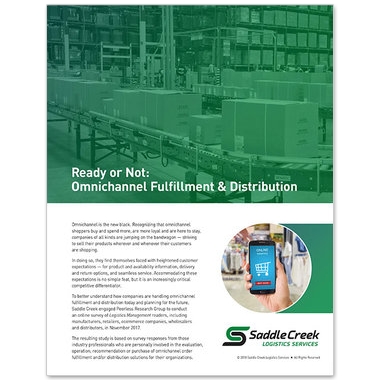Executive Brief for Saddle Creek – May 2018
Omnichannel is the new black. Omnichannel shoppers buy and spend more. They are more loyal and they are here to stay. Companies of all kinds are jumping on the omnichannel bandwagon. Therefore, they strive to sell their products wherever and whenever their customers are shopping.
In doing so, they find themselves faced with heightened customer expectations. Product and availability information, delivery and return options, and seamless service are some of the expectations. Likewise accommodating these expectations is no simple feat, but it is an increasingly critical competitive differentiator.
To better understand how companies handle fulfillment and distribution today and plan for the future, Saddle Creek engaged Peerless Research Group to conduct an online survey of Logistics Management readers, including manufacturers, retailers, ecommerce companies, wholesalers and distributors, in November 2017.
Saddle Creek engaged Peerless Research Group to conduct an online survey. The resulting study is based on survey responses from those industry professionals who are personally involved in the evaluation, operation, recommendation or purchase of omnichannel order fulfillment and/or distribution solutions for their organizations.
Of course, establishing a more sophisticated supply chain isn’t easy. As a result omnichannel poses a host of potential challenges related to order management, fulfillment and distribution, and respondents say they are experiencing many of them.
- Transportation-related issues
- Inventory management across multiple facilities
- Order processing issues
- Scalability to accommodate growth/fluctuations
Where omnichannel is headed
Omnichannel continues to evolve. For that reason the survey identifies a number of trends that are helping to shape the practice.
Ecommerce is exploding for companies, and survey data supports this. Thirty-seven percent of respondents say they will be adding ecommerce sales channels for their customers in the next two years while 26.1 percent plan to leverage their customers’ ecommerce channel. Another 20.2 percent plan to utilize third-party marketplaces like Amazon or eBay.


